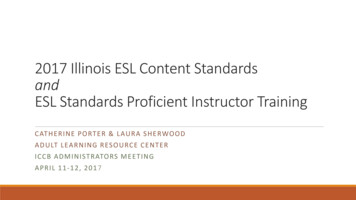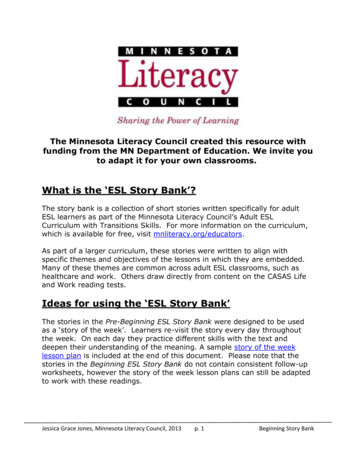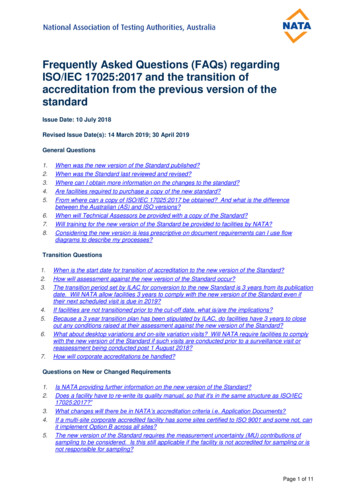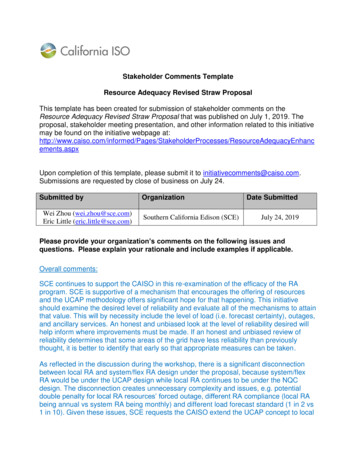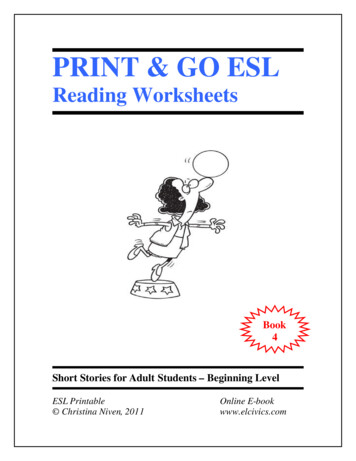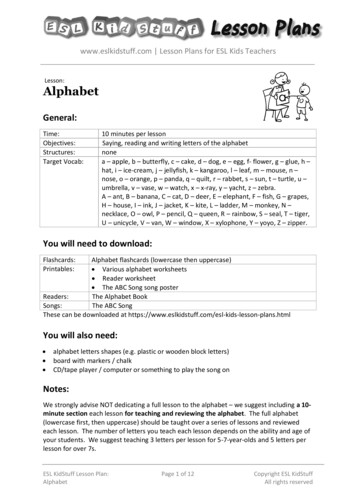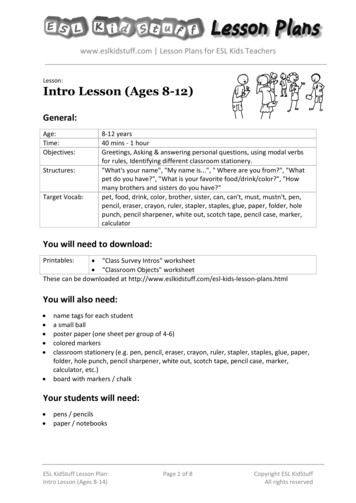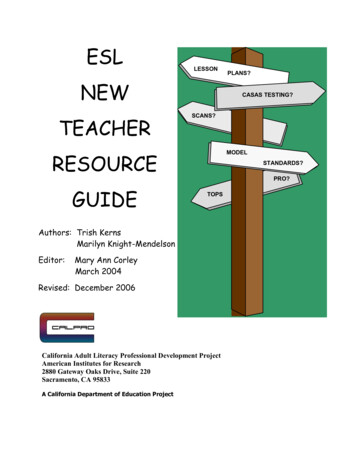
Transcription
ESLLESSONNEWTEACHERCASAS Authors: Trish KernsMarilyn Knight-MendelsonEditor:Mary Ann CorleyMarch 2004Revised: December 2006California Adult Literacy Professional Development ProjectAmerican Institutes for Research2880 Gateway Oaks Drive, Suite 220Sacramento, CA 95833A California Department of Education ProjectPLANS?
ContentsPage1IntroductionWho are My Students? The Adult ESL Learner2Before You Start Teaching: Questions to Ask aboutProcedures at Your Site3When You Start Teaching: Six-Stage ESL Lesson Plan5California Model Program Standards for ESL6ESL Instructional Techniques: Teacher Training Through8VideoAssessment and Accountability10Implications for Adult Educators of the “SCANS” Report1110 Easy Things You Can Do to Integrate Workplace Basics(SCANS Competencies) Into Your Classroom12General Strategies for Managing a Multi-level ESL Class13ESL Multi-level Model 114ESL Multi-level Model 215Resources for Adult Educators16AppendicesFrequently Asked Questions in Adult ESL Literacy:National Center for ESL Literacy EducationA-1aNeeds Assessment – BeginningA-2aNeeds Assessment – IntermediateA-2bAdditional Materials(Available through your CALPRO Professional Development Center)Teacher Training through Video: Lesson Planning. Longman, Inc.Model Standards for Adult Education Programs: ESL. California Department ofEducation, 1992.Handbook for Adult Education Instructors: ESL. California Department ofEducation, 1995.i
IntroductionTo a new English as a Second Language (ESL) teacher in an adult education program,the task of teaching English can seem overwhelming. This ESL New TeacherResource Guide, developed by the California Adult Literacy ProfessionalDevelopment Project (CALPRO), is designed to introduce you to the most immediateand important aspects of teaching adult ESL in California.A teacher new to ESL often asks such questions as, “Who will my new students be?”“What is their English proficiency?” “What materials should I use?” “How do Iassess my students and document their progress?” Many local agencies haveprocedures and practices that address these issues and will provide guidance to newteachers. The California Department of Education (CDE) has specific requirementsand also provides certain documents to guide you.This resource guide presents a brief overview of this information, providesexamples of the most important documents you will need, and leads you to resourcesthat will inform your teaching. The guide is available on the CALPRO Web site atwww.calpro-online.org. Relevant support materials (including a teacher training videoon ESL lesson planning and selected CDE publications) are available for loan fromthe CALPRO Professional Development Centers (PDCs). To locate and/or contactyour local PDC, visit the CALPRO Web site and click on “Professional DevelopmentCenters.” Then click on PDC Locator and select your county of residence. You will bedirected to the PDC that serves your region. You can also contact the CALPROOffice at 1-800-427-1422.Teaching ESL can be an exciting and fulfilling experience. We hope that this guidewill make your experience more manageable and rewarding.1
Who are My Students? The Adult ESL LearnerGetting to know your ESL learners should be one of your top priorities. Here are afew characteristics of adult learners to keep in mind.Adult Learners may: Represent a wide range of educational backgrounds. They may have from littleto no formal education in their native language, to completion of university andadvanced degrees in their native languages. In addition, they may or may nothave some previous education in English and/or in the United States. Be goal-oriented and highly motivated. They have come to you for a specificreason. Their goal(s) may be long or short term. They should be involved insharing and setting their learning goals. Bring different skills, interests, backgrounds, and life experiences to thelearning situation. They have rich life experiences, and the instructor shouldcapitalize on this diversity in the learning environment. Want or need immediate application. Adult learners need to apply what theyare learning. The learning tasks must be practical, have a clear purpose, anddirectly relate to their everyday lives. Have different learning styles. Adult learners often relate to their previouseducational experiences. Some may learn by doing, others by listening, speaking,reading, or writing. Many students learn better when there are visuals (pictures)or realia (real things, such as articles of clothing) to use. Be very busy. They may work more than one job in addition to going to schooland taking care of their families. They may be tired during class and havedifficulty staying on task for long periods of time. Have different levels of proficiency. Student levels may differ in listening,speaking, reading, and writing in both their first and second languages. Have a poor self-concept. Many people do not see themselves as learners. Somedo not think they can learn or that they know how to learn.Excerpted from the ESOL Starter Kit, Virginia Adult Learning Resource Center.October 2002, p. SLKit 2002.pdf2
Before You Start Teaching:Questions to Ask About Procedures At Your SiteMany types of agencies provide educational services to ESL students in California.You may be working or volunteering for an adult school run by a local school district,a community college, a library literacy program, a correctional facility, a countyoffice of education, or a community- or faith-based organization. You will want tofind out the answers to the following questions about your teaching assignmentbefore you start.1. What do I need to know about my classroom? What about the schoolsite?Where is my classroom? Is it locked? If so, who will open it?What are the security procedures?What hours and days will the classes be held? Will I work evenings orSaturdays?Is there an instructional aide to help out in the classroom?Is the room furnished appropriately for adults?Who is the agency contact person?Where are the restrooms? Are they always open?Is there a designated smoking area?Where can I park my car?Is there another teacher on site?Is there access to clerical staff and audio-visual and copier equipment onsite?2. What routine procedures at my teaching site do I need to know?What’s the procedure for getting paid?How do I handle student attendance? What forms are required and to whomdo I submit them? Is there a minimum and/or maximum number of studentsrequired for my class?How do I request substitute teachers?What is the instructional calendar?How do I obtain professional development?3. How are students registered and placed in my class?Your agency may have a formal process to register new students. In this case,when students enter your class, they will have completed an intake form andpossibly a placement test to determine their level of English proficiency.Some agencies, however, require that the teacher conduct the registration3
and placement process with new students. Ask your supervisor about yourresponsibilities in this area and about the forms, tests, and other resourcesthat are available to you.4. What is the level of the class I will be teaching?The California Department of Education publishes the Model Standards forAdult Education Programs: ESL. This publication defines seven levels ofEnglish language proficiency: Beginning Literacy, Beginning Low, BeginningHigh, Intermediate Low, Intermediate High, Advanced Low, and AdvancedHigh. If all your students fall into just one of these levels, you will beteaching a single-level class. This occurs most frequently in mid- or large-sizeprograms where there are several different levels of classes. It is commonpractice in smaller programs to place students of several proficiency levelsinto one class; this type of class is designated a “multi-level” class.5. How do I assess my students’ needs?Although it is obvious that your students come to school to learn English, theyhave individual needs and goals. Your agency may conduct a survey of studentneeds during the registration process, or you may be expected to administeryour own. For a few examples of ESL needs assessments, see Appendix, pagesA-2a, b.6. What is the core curriculum and what books and materials will beavailable to my students and me?Your site supervisor or ESL Coordinator most likely will provide you with thecore curriculum for the class you will be teaching. In addition, the ModelStandards for Adult Education Programs: ESL identifies topics and languageobjectives that are appropriate for each instructional level. Sample ESLcourse outlines also are available on the Outreach and Technical AssistanceNetwork (OTAN) website at www.otan.us. Click on OTAN for Teachers toaccess materials for classroom use. Your site supervisor will providetextbooks and other supplemental materials useful in teaching ESL. Thesemay include visuals, real-life objects, video programs, audio-visual equipment,computers, etc. For a list of instructional materials appropriate for certaintopics and levels, see the Quick Search Materials. Click on “Curriculum andResources” on the California Adult Student Assessment System (CASAS)Web site at www.casas.org.4
When You Start Teaching: Six-Stage ESL Lesson PlanHow do I plan and organize my lessons?The lesson plan format below often is used for effective instruction in adulteducation classes, especially for ESL learners.A. BEFORE YOU BEGIN . . .Set ObjectiveInstructor determines what learners will be able todo upon completion of this lesson.B. NOW PLAN THE LESSON . . .Lesson StageDefinition1. Warm-up and/orReviewInstructor provides an activity to focus learnerattention on the lesson objective and/or an activitythat encourages learners to use previously taughtskills/vocabulary that tie into the lesson.2. IntroduceInstructor establishes the purpose of the lesson bystating the objective and relating it to the learner’sown life. “After this lesson, you will be able to . . .”3. PresentInstructor presents new information and checks forcomprehension.4. PracticeLearners are provided opportunities to practice thenew knowledge that has been presented.5. EvaluateInstructor provides an activity that assessesindividual learners on their attainment of the lessonobjective.6. ApplyLearners use the language/information/material/ ina new situation.5
California Model Program Standards For ESLThe CDE publication, California Model Program Standards: ESL, providesprogrammatic, instructional, and assessment standards for adult ESL programs. As ateacher, you will be most interested in the instructional and assessment standards.Below are lists of the instructional standards and selected assessment standards.These provide general guidelines for teaching ESL and for evaluating your students.Instructional Standards1. Instructional activities integrate the four language skills(listening, speaking, reading, and writing) to emphasize theholistic nature of language.2. Language tasks in the classroom consist of meaningful interchanges that enhancestudents’ communicative competence.3. Instructional activities focus on the acquisition of communication skills necessaryfor students to function in real-life situations.4. Instruction focuses on the development of the receptive skills (listening andreading) before the development of the productive skills (speaking and writing).5. A variety of grouping strategies (whole-group, small-group, pair work, individualwork) are used in the classroom to facilitate student-centered instruction.6. Instructional activities are varied in order to address the different learningstyles (aural, oral, visual, kinesthetic) of the students.7. Instructional activities integrate language and culture so that students learnabout the U.S. culture in terms of significant and subtle characteristics 6
8. Learning activities develop the language necessary for students to access higherlevel thought processes (analysis, synthesis, and evaluation).9. Instructional activities require students to take active roles in the learningprocess, transferring critical thinking to real problem-solving situations intheir everyday lives.Excerpted from Model Standards for Adult Education Programs: ESL, California Department ofEducation, 1992.Selected Standards for Learner Assessment1. Students’ placements in ESL courses are determined by a variety of assessments.2. Instructors monitor students’ progress on a continuing basis, assessing studentson attainment of objectives identified in the course outline through use of a varietyof informal tests (applied performance procedures, observation, simulations) paperand pencil exams, and standardized tests.3. Assessments for moving from one level to another measure both general languageproficiency and master of specific instructional content.Excerpts from Model Standards for Adult Education Programs: ESL, California Department ofEducation, 1992.7
ESL Instructional Techniques: TeacherTraining Through VideoAn efficient way to familiarize yourself with instructionalstrategies appropriate for the ESL class is to work with the Teacher TrainingThrough Video series, published by Longman, Inc. You can work on these videos withan experienced teacher in your agency, or you can attend workshops hosted by yourlocal CALPRO Professional Development Center (PDC). You also can check out thevideos from your local PDC (See page 16 for PDC contact information). Below is a listof the techniques covered in the video series, with a brief description of each. AUser’s Guide, appropriate for the professional development of ESL teachers,accompanies each video.Beginning Literacy shows teachers how to group pre-literate, non-literate, semiliterate, andliterate students in the same classroom to teach reading and writing skills. Various groupingstrategies and instructional approaches based on students' backgrounds, goals, interests,and learning styles are presented as important aspects of literacy instruction.Dialogue Drill is an outgrowth of the audio-lingual method. It is used to develop speakingskills and pronunciation accuracy. The Dialogue places language structures in a context. TheDrills emphasize the teacher as a model that students mimic in order to practice grammar,pronunciation, and vocabulary.Early Production comes from the Natural Approach, which focuses on meaningfulcommunication rather than on the form of the language. Early Production emphasizescomprehensible input and is characterized by activities that require one- or two-wordresponses from students in the early stages of language learning.Focused Listening presents listening skills as strategies to bridge the gap betweenclassroom English and the English encountered outside the classroom.Information Gap instructs the teacher in how to develop activities that encourage studentsto communicate with each other in order to close a “gap” in the information they possess.The technique emphasizes the importance of real communication in the learning process.Language Experience is designed for preliterate, non-literate, and semiliterate students tolearn to read what they can already say. The technique emphasizes the concept that printrepresents spoken words. In this technique, students learn to recognize their own wordsbefore approaching other kinds of reading.8
Lesson Planning demonstrates how to plan an effective ESL lesson. It focuses attention onidentifying the language skills that are the primary objective of the lesson. It alsodemonstrates and provides practice in developing the six stages for an effective lessonplan: Warm-up/Review, Introduction, Presentation, Practice, Application, and Evaluation.Life Skills Reading provides practice in extracting information that will assist the readerin performing crucial tasks in the workplace or in daily life, using items such as ads, busschedules, and employee handbooks.Narrative Reading addresses reading in paragraph form, as in stories, textbooks ornewspapers. The technique focuses on global understanding and on the development ofreading skills.Problem Solving helps develop communicative competence and critical thinking skills. It usesstudents' concerns and problems as a subject for discussion. Students practice languageskills by making informed decisions based on a variety of solutions and their consequences.Role Play provides students with the opportunity to deal with the unpredictable nature oflanguage. The technique develops students' skills choosing verbal and non-verbalcommunication strategies in various contexts.Total Physical Response (TPR) demonstrates how to conduct a lesson based on theprinciple that listening naturally precedes speaking. During TPR activities, students listensilently to commands and respond non-verbally.Co-operative Learning is a series of four videos that instruct the teacher in how to set uplanguage learning activities that provide opportunities for students to interact with eachother in groups in order to build teams and promote individual accountability and positiveinterdependence.Contact your CALPRO Professional Development Center (PDC) to check out these videos!9
Assessment and Accountability1. What are TOPSpro forms and am I required to complete them?The California Adult Student Assessment System (CASAS) is responsible forcollecting certain demographic information for the California Department ofEducation (CDE) via a data-collection system known as TOPSpro. Every adulteducation student in every program must complete a TOPSpro form upon entering andexiting a class. This process must continue for the entire year. You will need to findout your agency’s procedures for obtaining, completing, and returning these forms.More information about this data collection system is available on the CASAS Website at www.casas.org.2. How do I track students’ goals and outcomes?The TOPSpro form also is used to record each student’s goals on entering a class(via the TOPSpro Entry Record), as well as their educational outcomes (via theTOPSpro Update Record). Your supervisor will tell you how to complete these formsand will provide information about other required follow-up procedures.3. What other measures can I use to assess my students?Assessment is an ongoing process in adult education, and multiple assessmentmeasures should be used. Assessment may be formal (e.g., a written test), or informal(e.g., teacher observation of student performance through a checklist ofcompetencies mastered). The assessment should reflect instructional objectives. Youragency may provide exit tests for each level, or it may use commercially availabletests, or you may be required to create your own. CASAS also provides exit tests forvarious instructional levels. Visit the CASAS Web site, www.casas.org, and click onCASAS Catalog to obtain information about these tests.4. What is CASAS testing and what are my responsibilities?CASAS provides CDE with an electronic system for collecting data on studentlearning gains via a series of pre- and post-tests. Certain funding streams requirethat these tests be administered regularly to document student progress. Ask yoursupervisor if your class needs to be “CASAS-tested” and what the agency’s testingprocedures are. The TOPSpro system allows you to generate reports from the resultsof your class’s tests to assist you in identifying areas in which your class hasstrengths or weaknesses. The TOPSpro Reports Manual available through CASASdetails each of the reports.10
Implications for Adult Educators of the “SCANS” ReportWhat Work Requires of Schools—The Secretary’s Commission on Achieving Necessary SkillsU.S. Department of Labor, June 1991Seeking employment or better employment is a major motivation of California’s adult learners. The Secretary’s Commission on AchievingNecessary Skills (SCANS) examined the demands of the workplace and whether adult students are capable of meeting those demands.The following three foundation skills and five competencies were identified as a result of discussions and meetings among businessowners, public employers, unions, and workers in shops, plants, and stores.The Commission ascertained that half of the people entering the workplace lack the knowledge and foundation required to find and hold agood job. The eight requirements listed below (foundation skills and competencies) lie at the heart of successful job performance andshould be incorporated into a sound adult education instructional program.Three-Part Foundation Skills1. Basic Skills reading writing arithmetic/mathematics listening speaking2. Thinking Skills creative thinking (creates new ideas) decision making (chooses best alternative, based on facts) problem solving (recognizes problem; creates and completes aplan of action) reasoning (uses logic to draw conclusions) knowing how to learn (uses efficient learning techniques) seeing things in the mind's eye (understands charts, symbols,pictures, etc.)3. Personal Qualities responsibility (works hard to attain a goal) self esteem (believes in own self-worth) sociability (gets along well with people) self-management (self-planning and control) integrity and honesty (chooses the right thing to do)Five Competencies1. Resources (uses each wisely) time materials and facilities personnel2. Interpersonal Skills works well with others teaches others new skills serves clients or customers works with people of diverse backgrounds acts as leader3. Uses Information acquires and evaluates information organizes and maintains information analyzes and communicates information uses computers to do above steps4. Works With Systems understands how systems work (organizational, technological,social) works within the system improves and designs systems5. Technology selects the right technology for the task uses technology to complete tasks maintains and trouble shoots technology11
10 Easy Things You Can Do To Integrate Workplace Basics(SCANS Competencies) Into Your ClassroomThe following list suggests ways to incorporate SCANS skills into your dailyinstruction. The bold-faced type indicates the classroom strategy, and the listbelow indicates the SCANS skill to which it corresponds.1. Start each class with an agenda on the board.SCANS:Information: organizingResources: allocating timeInterpersonal: negotiating2. Put students in teams and assign teams classroom maintenance jobs.SCANS:Interpersonal: working in teams, taking individual responsibilityPersonal Qualities: demonstrating sociabilitySystems: developing system to improve performance3. Conclude every lesson by calling attention to the workplace relevance of the lesson and the classroomactivities.SCANS:Systems: monitoring performance4. Teach students how to organize their classroom materials.SCANS:Interpersonal: teaching othersSystems: monitoring performance5. Monitor students’ progress with checklists and weekly tests.SCANS:Interpersonal: organizing and maintaining informationSystems: monitoring/correcting performance6. Pay attention to classroom incidents and conflicts. Develop lessons that teach students how to deal withthese issues appropriately.SCANS:Interpersonal: working in teams, negotiatingThinking skills: solving problems, making decisionsPersonal qualities: demonstrating sociability7. Model appropriate workplace behavior: arrive on time, come with an organized plan, dress appropriately,and maintain a positive attitude.SCANS:Personal qualities: taking responsibility, managing selfSystems: understanding systems8. Encourage students to use, fix, or make minor adjustments in equipment, such as hole punch, pencilsharpener, overhead projector, etc.SCANS:Technology: maintaining & troubleshooting equipment and applying technology to task9. Designate student trainers, tutors or experts who can train new students and assist classmates as needed.SCANS:Interpersonal: teaching othersSystems: improving or designing systems10. Encourage self and peer revision whenever possible. Teach the appropriate language to make revisions.SCANS:Systems: monitoring/correcting performanceInterpersonal: taking individual responsibilityPersonal qualities: assessing/managing selfD. Price-Machado & A. Damrau12
General Strategies for Managing a Multi-level ESL ClassMany adult ESL classes, especially those located off the main campus site(for example, in churches or community centers), serve the entire localcommunity and, hence, may have students of widely differing Englishproficiencies. This situation can provide challenges to the instructor. Thefollowing three pages offer some general strategies for addressing a “multilevel” class, as well as two models for managing the multi-level class. Contactyour CALPRO PDC Manager for additional materials or workshops onManaging the Multi-level ESL Class. First, administer a Needs Assessment to determine the number and levelof groups you will need in your class (see Appendix A-2a, b for sampleNeeds Assessment forms). Focus your instruction. Provide a self-contained lesson, one that can becompleted within the time frame of your class on any given day. Plan for all groups to work on the same general topic (although each groupmay have a different lesson objective). Begin and end your lesson with the whole group together to create asense of class community. Use a variety of teacher/student and student/student groupings (wholegroup, small group, pairs, individual) to allow for adequate practice of thelesson objective.For more information on managing the multi-level class, visit the ESOL StarterKit, Virginia Adult Learning Resource Center ”Teaching Multilevel Adult ESLClasses.” it 2002.pdf.13
ESL Multi-Level Model 1This model is used for a traditional classroom setting and delivery mode. Theteacher may be working with a textbook or using materials s/he has created.Groups are determined by their English proficiency level. The lesson topicfor both groups is the same, but the individual objectives for each group areappropriate to its level. For example,Lesson Topic:Lesson Objective: Beginning Level Intermediate LevelBuying Food in a SupermarketStudents will be able to name five items they buy atthe supermarket and match the words with pictures.Students will be able to describe the location ofseven items in the supermarket and ask the prices.Whole directedInstructionROTeacher presentsnew materialStudents work in groupson previously taughtmaterialsOUUP1PStudent-directed ActivityTeacher-directed InstructionStudents work on activities relatedto new material presentedTeacher reviews group work andprovides feedbackWhole ClassApplication ActivityClosureAdapted from Kentucky Educational Television’s ESL in Education: Teaching Multi-level Classes142
ESL Multi-Level Model 2This model is used in a non-traditional project-based classroom. Each groupworks on its own project, and there may be several groups workingsimultaneously. Groups may be determined by their English proficiencylevels, and also by their interest in specific projects, by their learning goals,or by other appropriate criteria. The topic of the project is the same for allgroups, although each group project may have a different focus. Forexample,General Topic:1. Buying Food in a SupermarketSample Group Topics:1. Compare pricing and nutritional information of items to be purchased inthe supermarket2. Create a budget for weekly purchases at the supermarketWhole ClassOpeningGroup 1Teacher monitors both groupsGroup 2Whole GroupShares projectsDemonstrates learningGroup 1TeacherGroup 2Whole GroupApplication ActivityClosureAdapted from Kentucky Educational Television’s ESL in Education: Teaching Multi-level Classes15
Resources for Adult Educators1. Professional Development Training and WorkshopsCALPRO (California Adult Literacy Professional Development Project)provides professional development opportunities and resources for adulteducators throughout the state. CALPRO supervises the activities of tenProfessional Development Centers (PDCs) that respond to the professionaldevelopment needs of adult education administrators and teachers at thelocal level. To find out who your PDC Manager is, go to http://www.calproonline.org/PDC. Click on the PDC Locator and find your county. Click on“submit” and the name of your PDC, with phone number and email, will appear.Check the web site: www.calpro-online.org/pdc for upcoming activities inyour area. Click on the name of your Professional Development Center, andthen click on Calendar to see the training opportunities that are available.Click on the name of the workshop to register online.2. Online Adult Education Informationwww.otan.usOTAN—Outreach & Technical Assistance Network—houses thelargest database of adult education materials in the world.Registration is required, but it’s free. Click on OTAN for Teachersto access a variety of materials and other resources for classroom use.3. Data Collection for Adult Learnerswww.casas.orgCASAS—The Comprehensive Adult Student Assessment System providesthe California Department of Education with a standardized, electronicsystem for collecting student demographic data and student learning gains.4. California Distance Learning Project www.cdlponline.orgCDLP - The goal of the California Distance Learning Project is to expandlearner access to adult basic education services in California throughdistance learning.16
5. Professional Associations for Adult EducatorsACSA—Association of California School Administrators www.acsa.orgCAEAA—California Adult Education Administrators’ Association www.caeaa.orgCATESOL—California Association of Teachers of English to Speakers ofOther Languages www.catesol.orgCCAE—California Council of Adult E
your own. For a few examples of ESL needs assessments, see Appendix, pages A-2a, b. 6. What is the core curriculum and what books and materials will be available to my students and me? Your site supervisor or ESL Coordinator most likely will provide you with the core curriculum f


